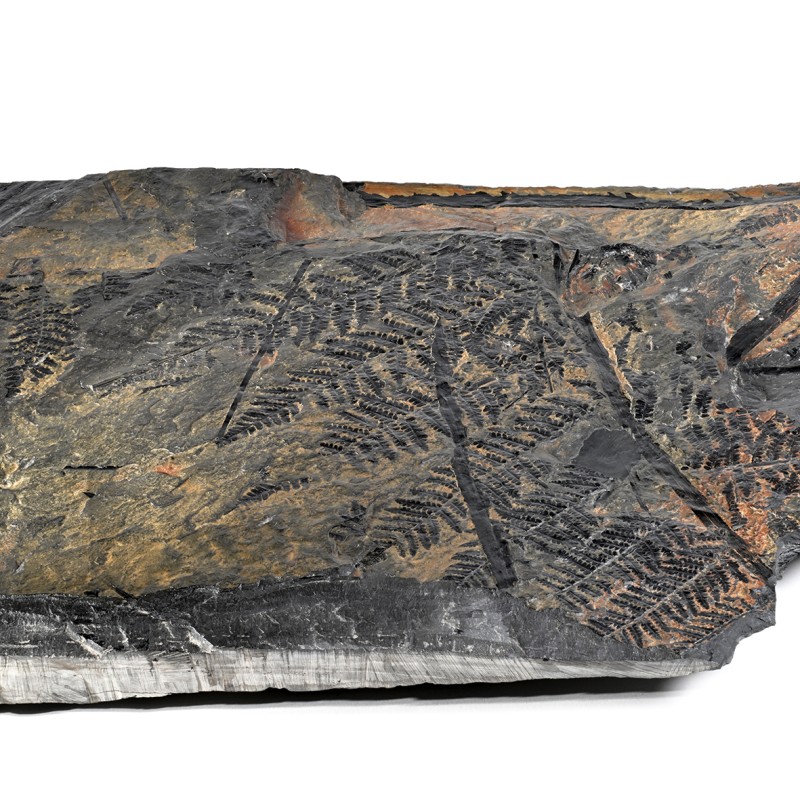“Fire and Ice - Climate Extremes throughout Earth’s History”
21. March 2024
A new special exhibition by the Natural History Museum Vienna at the Lower Austria’s Fossil World
The Fossil World, located just outside of Vienna, will reopen its doors after its winter break on Easter Monday 1 April 2024,
with a new exhibition curated by the NHM Vienna. The exhibit “Fire and Ice - Climate Extremes throughout Earth’s History”
will take us back to a tropical past when parts of Austria were covered by a sea so warm it would have been possible to swim
in it in winter.
Compared to the climate fluctuations in Earth’s history, however, this tropical interlude 16 million years ago is hardly worth mentioning. Over billions of years, the Earth’s climate has repeatedly veered off course, turning our world at times into an inhospitable ice planet or a sweltering hellscape.
We are currently living in a warm phase of an ice age that began 2.6 million years ago. Earth’s changing orbit and shifts in the orientation of its axis have led to very cold periods alternating with relatively warm phases ever since. The current ice age reached its last cold peak around 25,000 years ago, when the province of Lower Austria was transformed into a barren steppe and was home to mammoths. However, the ice age 700 million years ago was much more dramatic, when even the oceans were largely frozen over. This frozen wasteland almost spelled the end for life on our planet. One of the reasons for this was that the Sun’s radiance was much less powerful at the time. Earth was saved by volcanoes, which blew carbon dioxide, a greenhouse gas, into the atmosphere, reheating the planet.
A stark contrast to this ice planet was the super greenhouse that dominated the planet 250 million years ago. At that time, most of today’s continents were fused into a single gigantic continent, Pangaea. There were barely any clouds above this enormous landmass, which became extremely dry and hot with annual temperatures averaging over 40° C. Life once again faced a dramatic crisis. Forests disappeared and deserts spread across large parts of Europe. More than 96% of all animal life died out. However, the hard shells of reptile eggs now proved to be a survival advantage, protecting the animals from drying out. Without the climate catastrophe 250 million years ago, the dinosaurs would never have evolved and ultimately we humans would not be here either. Like all mammals, we are descended from a primitive group of reptiles that was perfectly adapted to the harsh conditions of Pangaea.
The next ice age is due in 15,000 years according to the scheduled alternation between cold and warm periods. The Vienna Woods would give way to tundra and steppe; Innsbruck would be buried under glaciers. However, global warming caused by humans may already have interrupted this natural rhythm. How will the climate evolve against the backdrop of geological timeframes?
There is no landmass today that would match the hellscape of Pangaea. In a few million years’ time, the continents will still be surrounded by oceans, allowing moisture to move across land. A look back to the Carboniferous period opens up a possible window on the future. In this hot, humid climate 330 million years ago, dense swamp forests spread across Europe for the first time. Giant dragonflies with wingspans of over 80 centimetres flew among the trees, and massive amphibians populated the swamps. Back then, the carbon dioxide content of the atmosphere fluctuated between 400 and 800 ppm. Today we have already reached the lower limit of the Carboniferous period.
Over millions of years, plants stored CO2 in their trunks and leaves, which was transformed into coal in the swamps. Today we are burning this coal-based CO2, releasing it back into the atmosphere over just a few decades – with incalculable consequences.
Is our path leading us back to carbon? Does the past reveal possible scenarios for the future? The special exhibition curated by the Department of Geology and Palaeontology of the Natural History Museum Vienna at the Fossil World in Lower Austria provides us with some excellent food for thought.
Where: Fossilienwelt GmbH, Austernplatz 1, 2100 Stetten
T +43 (0)2262/62409
Opening hours:
1 April 1 to 31 October 2024
Tue - Sun from 10 am to 5 pm,
last admission 3:30 pm
Closed Mondays (except public holidays).
Press material:
https://www.nhm-wien.ac.at/presse/pressemitteilungen2024/fossilienwelt
For scientific inquiries:
Prof. Dr. Mathias Harzhauser,
Director of the Department of Geology and Paleontology, NHM Vienna
https://www.nhm-wien.ac.at/mathias_harzhauser
Phone: + 43 (1) 521 77 - 250
mathias.harzhauser@nhm-wien.ac.at
For general inquiries:
Irina Kubadinow
Head of Press Department, Press Spokesperson, NHM Vienna
https://www.nhm-wien.ac.at/irina_kubadinow
Tel.: + 43 (1) 521 77 - 410
irina.kubadinow@nhm-wien.ac.at
Nikolett Kertész-Schenk, Bakk. BA MAS
Press Department, NHM Vienna
https://www.nhm-wien.ac.at/nikolett_kertesz
Tel.: + 43 (1) 521 77 - 626
nikolett.kertesz@nhm-wien.ac.at
Compared to the climate fluctuations in Earth’s history, however, this tropical interlude 16 million years ago is hardly worth mentioning. Over billions of years, the Earth’s climate has repeatedly veered off course, turning our world at times into an inhospitable ice planet or a sweltering hellscape.
We are currently living in a warm phase of an ice age that began 2.6 million years ago. Earth’s changing orbit and shifts in the orientation of its axis have led to very cold periods alternating with relatively warm phases ever since. The current ice age reached its last cold peak around 25,000 years ago, when the province of Lower Austria was transformed into a barren steppe and was home to mammoths. However, the ice age 700 million years ago was much more dramatic, when even the oceans were largely frozen over. This frozen wasteland almost spelled the end for life on our planet. One of the reasons for this was that the Sun’s radiance was much less powerful at the time. Earth was saved by volcanoes, which blew carbon dioxide, a greenhouse gas, into the atmosphere, reheating the planet.
A stark contrast to this ice planet was the super greenhouse that dominated the planet 250 million years ago. At that time, most of today’s continents were fused into a single gigantic continent, Pangaea. There were barely any clouds above this enormous landmass, which became extremely dry and hot with annual temperatures averaging over 40° C. Life once again faced a dramatic crisis. Forests disappeared and deserts spread across large parts of Europe. More than 96% of all animal life died out. However, the hard shells of reptile eggs now proved to be a survival advantage, protecting the animals from drying out. Without the climate catastrophe 250 million years ago, the dinosaurs would never have evolved and ultimately we humans would not be here either. Like all mammals, we are descended from a primitive group of reptiles that was perfectly adapted to the harsh conditions of Pangaea.
The next ice age is due in 15,000 years according to the scheduled alternation between cold and warm periods. The Vienna Woods would give way to tundra and steppe; Innsbruck would be buried under glaciers. However, global warming caused by humans may already have interrupted this natural rhythm. How will the climate evolve against the backdrop of geological timeframes?
There is no landmass today that would match the hellscape of Pangaea. In a few million years’ time, the continents will still be surrounded by oceans, allowing moisture to move across land. A look back to the Carboniferous period opens up a possible window on the future. In this hot, humid climate 330 million years ago, dense swamp forests spread across Europe for the first time. Giant dragonflies with wingspans of over 80 centimetres flew among the trees, and massive amphibians populated the swamps. Back then, the carbon dioxide content of the atmosphere fluctuated between 400 and 800 ppm. Today we have already reached the lower limit of the Carboniferous period.
Over millions of years, plants stored CO2 in their trunks and leaves, which was transformed into coal in the swamps. Today we are burning this coal-based CO2, releasing it back into the atmosphere over just a few decades – with incalculable consequences.
Is our path leading us back to carbon? Does the past reveal possible scenarios for the future? The special exhibition curated by the Department of Geology and Palaeontology of the Natural History Museum Vienna at the Fossil World in Lower Austria provides us with some excellent food for thought.
Where: Fossilienwelt GmbH, Austernplatz 1, 2100 Stetten
T +43 (0)2262/62409
Opening hours:
1 April 1 to 31 October 2024
Tue - Sun from 10 am to 5 pm,
last admission 3:30 pm
Closed Mondays (except public holidays).
Press material:
https://www.nhm-wien.ac.at/presse/pressemitteilungen2024/fossilienwelt
For scientific inquiries:
Prof. Dr. Mathias Harzhauser,
Director of the Department of Geology and Paleontology, NHM Vienna
https://www.nhm-wien.ac.at/mathias_harzhauser
Phone: + 43 (1) 521 77 - 250
mathias.harzhauser@nhm-wien.ac.at
For general inquiries:
Irina Kubadinow
Head of Press Department, Press Spokesperson, NHM Vienna
https://www.nhm-wien.ac.at/irina_kubadinow
Tel.: + 43 (1) 521 77 - 410
irina.kubadinow@nhm-wien.ac.at
Nikolett Kertész-Schenk, Bakk. BA MAS
Press Department, NHM Vienna
https://www.nhm-wien.ac.at/nikolett_kertesz
Tel.: + 43 (1) 521 77 - 626
nikolett.kertesz@nhm-wien.ac.at



